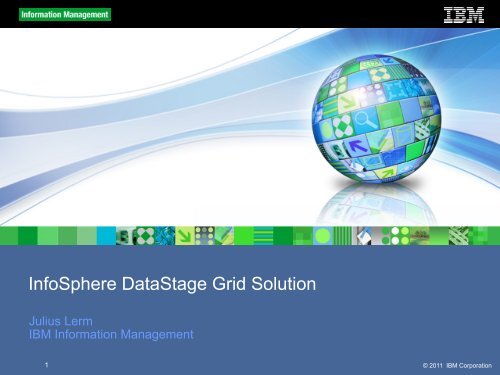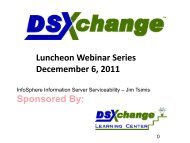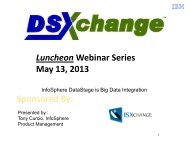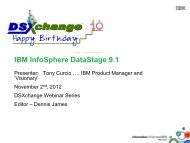Infosphere datastage grid solution - dsxchang - DSXchange.net
Infosphere datastage grid solution - dsxchang - DSXchange.net
Infosphere datastage grid solution - dsxchang - DSXchange.net
Create successful ePaper yourself
Turn your PDF publications into a flip-book with our unique Google optimized e-Paper software.
InfoSphere DataStage Grid Solution<br />
Julius Lerm<br />
IBM Information Management<br />
1<br />
© 2011 IBM Corporation
What is Grid Computing?<br />
Grid Computing doesnt mean the same thing to all people.<br />
GRID<br />
• Definitions include:<br />
• Using Idle machines on the inter<strong>net</strong><br />
• Using Idle desktop machines within the company<br />
• Using any server thats not currently in use<br />
• Regardless of OS, physical Location, CPU speed …<br />
• Anything running more than 1 Linux box in any manner<br />
• Anything running on any computer when you dont care which<br />
computer it runs on<br />
© 2009 IBM Corporation
What is Grid Computing with InfoSphere DataStage?<br />
• Low cost <strong>solution</strong> that provides high throughput processing<br />
• InfoSphere DataStage Grid Toolkit<br />
• Allows for maximum resource allocation flexibility to one or<br />
more project teams<br />
• Available for DataStage, QualityStage, and Information<br />
Analyzer<br />
• Enables both <strong>grid</strong> distribution methods simultaneously<br />
• assigning jobs to specific servers in the <strong>grid</strong><br />
• assigning a single parallel job to run across multiple servers<br />
• Platforms:<br />
• RedHat or SuSE (Intel/AMD)<br />
• AIX/Power<br />
© 2009 IBM Corporation
What Is Driving Rapid Customer Adoption of Data Integration<br />
Grid?<br />
Value $$<br />
Better decisions based on better data yields ROI$$$<br />
• Grid-based integration makes it possible for companies to process and analyze larger<br />
data volumes, create a consolidated view of data, and put the right data into the<br />
enterprise data warehouse and other critical enterprise applications<br />
• More sources of data, more data from each source, better matching, real-time versus batch<br />
• Better data yields:<br />
• Better business decisions<br />
• Enhanced customer relationships<br />
• More cross selling and upselling<br />
• New services delivered to customers<br />
Reduced Data Integration Costs<br />
• Reduced administration and operating costs – centralization of staff<br />
• Reduced data integration project costs – lower cost per project delivered by data<br />
integration center of excellence versus siloed projects<br />
• Reduced hardware costs<br />
Cost $$<br />
© 2009 IBM Corporation
Benefits of Grid Computing<br />
• Low cost hardware<br />
• High-throughput processing<br />
• Significant ROI (Return on Investment) for data management<br />
<strong>solution</strong>s<br />
• Supports a high-availability (HA) <strong>solution</strong><br />
• Resource manager monitors availability of hardware at startup / job<br />
deployment time<br />
• SLA (Service Level Agreement)<br />
• Consistent runtimes<br />
• Isolates concurrent job executions<br />
• Shared resource pool<br />
• Not typical silo-ed environment<br />
• Hardware shared across multiple environments and departments<br />
© 2009 IBM Corporation
Why Grid?<br />
Improve the return on infrastructure investments!<br />
Ø Help improve infrastructure price/performance<br />
Ø Improve the utilization of computing resources<br />
Ø Help provide unlimited scalability and offer capacity on demand<br />
Ø Optimize the allocation of resources to applications<br />
Ø Help reduce complexity, consolidate servers, storage and data centers<br />
Ø Provide a highly available environment<br />
Ø Help eliminate single points of failure<br />
Ø Optimize use of available processing resources<br />
Ø Ensures that application tasks complete within stable predictable time<br />
frame à improving SLA performance<br />
© 2009 IBM Corporation
Before Grid<br />
ProfileStage DataStage QualityStage DataStage ...<br />
Project 1 Project 2 Project 3 Project 4<br />
IBM Software<br />
Project N<br />
SMP 1 SMP 2 SMP 3 SMP 4 SMP N<br />
Silo-ed architecture & proliferation of SMP servers:<br />
• Higher capital costs through limited pooling of IT assets across silos<br />
• Higher operational costs<br />
• Limited responsiveness due to more manual scheduling and provisioning<br />
• Inherently more vulnerable to failure<br />
• No ability to exploit available capacity when other teams are idle<br />
© 2009 IBM Corporation
After Grid<br />
ProfileStage<br />
Project 1<br />
DataStage<br />
Project 2<br />
QualityStage<br />
Project 3<br />
DataStage<br />
Project 4<br />
...<br />
IBM Software<br />
Project N<br />
DataStage Multi-Process Grid Framework<br />
Grid enables<br />
increased efficiency,<br />
responsiveness,<br />
variability and speed.<br />
• Virtualized infrastructure:<br />
Node 1 Node 2 Node 3 Node 4<br />
• Creates a virtual data integration collaboration environment<br />
• Virtualizes application services execution<br />
...<br />
Node N<br />
• Dynamically fulfills requests over a virtual pool of system resources (nodes)<br />
• Offers an adaptive, self-managed operating environment that guarantees high<br />
availability<br />
• Delivers maximum available capacity to anyone participating in the <strong>grid</strong><br />
Eliminates The<br />
SMP nightmare,<br />
Allows Unlimited<br />
Scalability<br />
© 2009 IBM Corporation
InfoSphere DataStage Grid Definition<br />
It’s an InfoSphere DataStage Cluster that<br />
supports the dynamic creation of Config<br />
Files<br />
• All the requirements for a Cluster apply<br />
• Adds<br />
• Resource Manager<br />
• Grid Toolkit (GTK)<br />
© 2009 IBM Corporation
Cluster Requirements<br />
• Shared Storage<br />
• NIS/LDAP<br />
• Networking<br />
• Passwordless SSH<br />
• HA Solution<br />
• DB Connectivity<br />
• Users<br />
• Review System Requirements<br />
Platform Requirements Usually Implemented<br />
by Client’s own sysadmins and storage/<br />
<strong>net</strong>working personnel<br />
© 2009 IBM Corporation
Sample IS Grid<br />
© 2009 IBM Corporation
Resource Management<br />
• Tracks resources (nodes) based on which jobs are already running,<br />
which servers are down<br />
• Queues jobs when no resources are available<br />
• Provides a list of nodes that are assigned for a job<br />
• Extensive advanced features<br />
• We leverage a subset of the features<br />
• Manager node where tasks are scheduled and resources allocated<br />
• Usually happens on the head node<br />
• Compute nodes have agent processes that communicate back to<br />
the manager<br />
• Jobs (scripts or executables) are started on compute node, not<br />
head node<br />
© 2009 IBM Corporation
LoadLeveler Classes<br />
• LoadL_admin file:<br />
dsbatch: type = class # class for medium jobs<br />
priority = 50<br />
# ClassSysprio<br />
max_total_tasks = 50<br />
class_comment = "Class for DataStage batch jobs“<br />
dsrealtime: type = class # class for medium jobs<br />
priority = 50<br />
# ClassSysprio<br />
max_total_tasks = 50<br />
class_comment = "Class for DataStage batch jobs“<br />
• LoadL_config.local:<br />
CLASS = dsbatch(4) dsrealtime(3)<br />
© 2009 IBM Corporation
Grid Enablement Toolkit<br />
• What does it do?<br />
• Prebuilt integration with resource managers<br />
• Coordinates activities between the parallel framework<br />
and the resource manager<br />
• Creates the parallel configuration file to drive the dynamic<br />
assignment of compute resources<br />
• Logging (interaction w/ RM, usage details)<br />
© 2009 IBM Corporation
© 2009 IBM Corporation
Grid Environment Variables In Administrator<br />
© 2009 IBM Corporation
Grid Toolkit Environment Variables<br />
• APT_GRID_ENABLE<br />
• YES: Current osh will intercept the run script to create a new configuration file<br />
• NO: Use the existing configuration file<br />
• APT_GRID_QUEUE<br />
• Name of the Resource Manager queue the job will be submitted to<br />
• APT_GRID_COMPUTE_NODES<br />
• The number of compute nodes required for the job<br />
• Used to request the number of compute nodes in the dynamically created<br />
configuration file<br />
• A compute node is a server that can be used for processing<br />
• Not e.g. dedicated for IO or DB2<br />
• Default value is 1<br />
• APT_GRID_PARTITIONS<br />
• Used to create multiple partitions for each compute node<br />
• Default value is 1<br />
© 2009 IBM Corporation
© 2009 IBM Corporation
Dynamic Config file<br />
Dynamic Config File<br />
Static Config File<br />
19<br />
© 2009 IBM Corporation
Grid Config Template<br />
20<br />
© 2009 IBM Corporation
Generated Config<br />
APT_GRID_COMPUTENODES=3<br />
21<br />
© 2009 IBM Corporation
Information Server (IS) Grid Solution Offering<br />
A total <strong>solution</strong> approach to implement an Information Server Grid system<br />
based on proven methods & best practices<br />
Features<br />
This offering consists of the following phases:<br />
§ Education & Project Planning<br />
22<br />
§<br />
Common understanding of IS Grid<br />
§ Architecture & Design<br />
§<br />
Customer responsible for building the<br />
Grid Infrastructure<br />
§ IS Grid Implementation<br />
§<br />
§<br />
§<br />
§<br />
Install & configure the IS Grid<br />
Framework<br />
Test & Validate<br />
Address Administration Hand-Off<br />
Monitor during 24 hours<br />
Backed by world class industry and<br />
product experts in deploying<br />
InfoSphere software<br />
Benefits<br />
§ Leverage repeatable, proven processes and<br />
standard collaterals to reduce costs and project<br />
risks<br />
§ Accelerate the time to value and return on<br />
investment with the knowledge and best practices<br />
brought by our Information Server Grid experts<br />
§ Gain knowledge transfer and mentoring from our<br />
experts<br />
Deliverables<br />
§ Environment Prerequisite Checklist<br />
§ Grid Planning & Architecture Document<br />
§ Project Plan<br />
§ System Configuration Guide<br />
§ Standard Collateral<br />
§<br />
§<br />
§<br />
Build your own Grid Toolkit<br />
Grid Enablement Toolkit<br />
Basic High Availability<br />
© 2009 IBM Corporation
Project Approach<br />
Educatio<br />
n &<br />
Project<br />
Planning<br />
Ø Education & Project Planning Workshop (1 week)<br />
• Educate/obtain a common understanding about a <strong>grid</strong> environment<br />
• Start to create a customer environment prerequisite checklist<br />
Ø Architecture & Design Workshop (15 days spread in 3 to 4 weeks)<br />
• Interactive discussion/collaboration with the customer to finalize the architecture of the <strong>grid</strong><br />
environment<br />
• Finalize the customer environment prerequisite checklist<br />
Ø Implementation of the Infrastructure by Customer or GTS<br />
…<br />
• Following the customer environment pre-requisite checklist (System Requirements)<br />
Ø IS Grid Implementation (3 weeks)<br />
Implementatio<br />
n by<br />
Customer<br />
…<br />
Architecture<br />
Design<br />
IS Grid<br />
Implem<br />
entatio<br />
n<br />
• Review/check that the customer environment is ready<br />
• Install & Configure Information Server Grid Framework based on the defined architecture<br />
• Migrate existing parallel DataStage jobs & sequences (max. 50) to the new environment (optional, as<br />
needed)<br />
• Two days monitoring period<br />
One SOW that includes all three Phases<br />
…<br />
© 2009 IBM Corporation
Deliverables<br />
Ø Education & Project Planning Workshop<br />
• Understanding all infrastructure implication<br />
to operate a GRID Environment (Standard Collaterals)<br />
• Build your own Grid Toolkit<br />
• Grid Enablement Toolkit<br />
• Basic High Availability<br />
• Project Plan<br />
Ø Architecture Design<br />
• Environment Prerequisite Checklist<br />
• Grid Planning & Architecture<br />
Ø IS Grid Implementation<br />
• Grid Toolkit Software<br />
• System Configuration Guide<br />
• Validated Test<br />
© 2009 IBM Corporation
Education Prerequisite<br />
Code Name Audience Duration<br />
DX444<br />
DataStage<br />
Essentials<br />
Learn about DataStage V8.1 in its IBM<br />
Information Server environment. Learn<br />
how to build DataStage parallel jobs<br />
that read and write data to and from a<br />
variety of data stores including<br />
sequential files, data sets, and<br />
relational tables. Also, learn how to<br />
build parallel jobs that process data in<br />
a variety of ways: business<br />
transformations, data filtering, data<br />
combining, data generation, sorting,<br />
and aggregating.<br />
4 days<br />
© 2009 IBM Corporation
Other Reference<br />
Ø GTS Grid Offerings:<br />
• http://spimweb1.boulder.ibm.com/services/sosf/dyno.wss?oid=625#1<br />
Ø GTS - Implementation Services for SAN storage software<br />
• http://spimweb1.boulder.ibm.com/services/sosf/dyno.wss?oid=771<br />
Ø GTS - Implementation Services for Network Attached Storage systems<br />
• http://spimweb1.boulder.ibm.com/services/sosf/dyno.wss?oid=805<br />
Ø Grid Redbook:<br />
• http://www.redbooks.ibm.com/redbooks/pdfs/sg247625.pdf<br />
Ø White Paper:<br />
• http://w3-103.ibm.com/software/xl/services/document/getAttachment/document/P911991A56203I41/<br />
attachment/IMW12027-USEN-00.pdf<br />
Ø Tivoli Dynamic Workload Broker:<br />
• http://www-304.ibm.com/jct03001c/services/learning/ites.wss/us/en?<br />
pageType=course_description&courseCode=TO075<br />
© 2009 IBM Corporation





